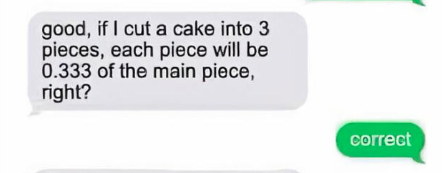These are bad:
What’s purple and commutes?
An abelian grape.
What’s yellow and equivalent to the Axiom of Choice?
Zorn’s Lemon.
Let’s not forget Number Theory, where being too transcendental can lead to problems.
I got another hotel room joke:
A theologician, a physicist and a mathematician are staying together in a hotel apartment. In the middle of the night, there’s a fire in another room, but the staircase is blocked, so they only way out is to jump from a window into the hotel pool down below.
The theologician is first. They sit on the window sill, make a short prayer and then push themselves off. Unfortunately, they miss the pool. Man proposes, god disposes.
The physicist is next. They estimate distances, carefully check the wind, and make the according calculations. They sit on the window sill, take a deep breath, and push themselves off with just the right amount of impulse. It all works out, they hit the pool and are saved.
The mathematician thinks: the physicist could do it, so I should be even more capable of making it! They just do as the physicist: They estimate distances, carefully check the wind, and make the according calculations. They sit on the window sill, take a deep breath, and push themselves off with just the right amount of impulse. But instead of plunging down into the pool, they fly up in the air! What happened?
Sign error.
there are 10 kind of people : those that know ternary, those that do not, and those that expected the joke to be about binary.
there’s 3 kinds of people, those who can count and those who can’t.
There are two hard problems in software engineering: cache invalidation, naming things, and off-by-one errors.
This is the bit that is wrong, of course.

The correct answer is closer to 0.3333333333333333333333333333333333333333333333333333333333333333333333333333333333333333333333333333333333333333333333333
or 0.3’
It’s a recurring error that many people make.
Interesting to me that I’m sure I was taught to use the above method for indicating a recurring digit (like an apostrophe), but today it is apparently a dot or line above the last digit.
When and where were you taught? I’ve seen probably 80 year old textbooks using the line, so it’s not really recent.
One word: Rechenschiebergenauigkeit
.
I learned the line in high-school in the early 90s, so it’s been around a while.
UK some 50-60 years ago. But I may have misremembered, too. But I never knew about dots or lines and I was taught about recurring numbers. (Maybe it was an informal hangover from when typewriters could not do the dot or line thing above a digit?)
I learned the line over in the 1960s: you are OLD, man!
I don’t think you’re misremembering, I’ve seen it before.
The big problem with it is the ambiguity, so I’m surprised it was taught even that recently.
I went to a very traditional/old-fashioned school (we did Latin FFS!). And at least one maths teacher was as old then as I am now!
(And thanks for confirming I am not losing all my marbles!)
So have the textbooks in Saskatchewan high schools, it seems… ![]()
I mean we’ve had a conservative government here for almost 2 decades, of course the schools are underfunded and in crisis!
How do you fit that over the last digit?


